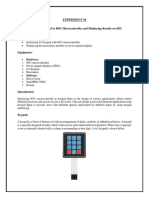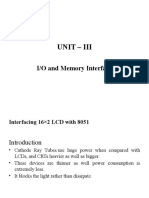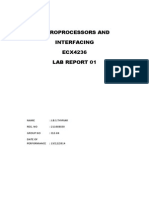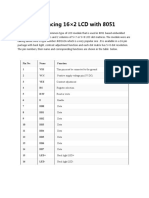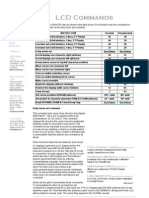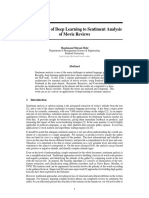50%(2)50% found this document useful (2 votes)
886 views2x16 LCD and 4x4 Keypad Interfacing With 8051 in Assembly Language
2x16 LCD and 4x4 Keypad Interfacing With 8051 in Assembly Language
Uploaded by
Abraham MuñozThis document provides a tutorial on interfacing a 2x16 LCD and 4x4 keypad with an 8051 microcontroller in assembly language. It describes connecting the LCD data bus and control lines to specific ports and scanning the keypad by polling each column individually. The program displays the key pressed on the LCD. The code includes functions for sending commands, writing data, and delay. It initializes the LCD, continuously scans the keypad columns, and displays the pressed key.
Copyright:
© All Rights Reserved
Available Formats
Download as DOCX, PDF, TXT or read online from Scribd
2x16 LCD and 4x4 Keypad Interfacing With 8051 in Assembly Language
2x16 LCD and 4x4 Keypad Interfacing With 8051 in Assembly Language
Uploaded by
Abraham Muñoz50%(2)50% found this document useful (2 votes)
886 views19 pagesThis document provides a tutorial on interfacing a 2x16 LCD and 4x4 keypad with an 8051 microcontroller in assembly language. It describes connecting the LCD data bus and control lines to specific ports and scanning the keypad by polling each column individually. The program displays the key pressed on the LCD. The code includes functions for sending commands, writing data, and delay. It initializes the LCD, continuously scans the keypad columns, and displays the pressed key.
Copyright
© © All Rights Reserved
Available Formats
DOCX, PDF, TXT or read online from Scribd
Share this document
Did you find this document useful?
Is this content inappropriate?
This document provides a tutorial on interfacing a 2x16 LCD and 4x4 keypad with an 8051 microcontroller in assembly language. It describes connecting the LCD data bus and control lines to specific ports and scanning the keypad by polling each column individually. The program displays the key pressed on the LCD. The code includes functions for sending commands, writing data, and delay. It initializes the LCD, continuously scans the keypad columns, and displays the pressed key.
Copyright:
© All Rights Reserved
Available Formats
Download as DOCX, PDF, TXT or read online from Scribd
Download as docx, pdf, or txt
50%(2)50% found this document useful (2 votes)
886 views19 pages2x16 LCD and 4x4 Keypad Interfacing With 8051 in Assembly Language
2x16 LCD and 4x4 Keypad Interfacing With 8051 in Assembly Language
Uploaded by
Abraham MuñozThis document provides a tutorial on interfacing a 2x16 LCD and 4x4 keypad with an 8051 microcontroller in assembly language. It describes connecting the LCD data bus and control lines to specific ports and scanning the keypad by polling each column individually. The program displays the key pressed on the LCD. The code includes functions for sending commands, writing data, and delay. It initializes the LCD, continuously scans the keypad columns, and displays the pressed key.
Copyright:
© All Rights Reserved
Available Formats
Download as DOCX, PDF, TXT or read online from Scribd
Download as docx, pdf, or txt
You are on page 1of 19
2x16 LCD And 4x4 Keypad Interfacing
With 8051 in Assembly Language
Microcontrollers are just silicon wafers until we tell them what to do, program them
according to our requirement. Similarly any user interface is incomplete without an Input.
One, two pushbuttons can be easily interfaced however if more user inputs are required it
can take up a lot of I/O lines. So here is a small tutorial to interface a 4x4 Matrix Keypad
and displaying the key pressed on a LCD. The microcontroller used is AT89C51 and the
coding has been done in assembly language.
The 4x4 Keypad has 16 keys and requires a single PORT or 8 I/O lines. Port 3 has been
designed to handle keypad, LCD Data Bus D7-D0 is connected to PORT 1, while
(Enable) EN is connected to P2.0
(Register Select Command or Data Register) RS is connected to P2.1
(Read/Write) RW is connected to P2.2
The LCD is based on Hitachi HD44780 Controller and datasheet is present online.
Working:
To check for the keystroke, a polling method has been used.
PORT 3.0
Key 1
Key 2
Key 3
Key 4
PORT3.1
Key 5
Key 6
Key 7
Key 8
PORT3.2
Key 9
Key 10
Key 11
Key 12
PORT3.3
Key 13
Key 14
Key 15
Key 16
PORT3.4
PORT3.5
PORT3.6
PORT3.7
The connections are similar as shown over here. Now consider this, if I select the first
column only, it has 4 keys, 1, 5,9,13. If a change of value (i.e. Binary 1 or 0) is made any
one of these keys, it can be decoded and suitable message is displayed on the LCD. This is
exactly what happens. Initially all the I/O lines are pulled high, then during Key Scan,
every column linked is held low for a little time. If during that time a Key is pressed in that
column a row I/O lines is also held low, thus the keystroke can be captured.
The obvious question would be what if we press the key on a particular column and at that
particular moment that column has not been pulled low, thus making no signal changes?
The answer is simple, the microcontroller runs quite fast, even a convention 89c51 in which
the internal frequency= external frequency clock/12 can achieve 2 MIPS at 24MHz. That is
2 Million instructions Per Second. This method is not foolproof, it has a drawback, while
the Key Scan, It cannot perform other cumbersome operations which may take time and a
Key Stroke could be missed. The program will work very well for small operations like
activating a small relay or LED when a Key is pressed, but for people who want their
systems to be near to perfect they may utilize other method.
Circuit Diagram
Each I/O line on PORT 1 should be pulled high with 4.7K Resistors
Program:
EN equ P2.0
RS equ P2.1
RW equ P2.2
mov A,#38H ; Setting Up the LCD
lcall command
mov A,#0EH ; Display On
lcall command
mov A,#06H ; Entry Mode
lcall command
mov a,#82H
lcall command
lcall disp ; Function Disp Called
mov a,#02H ; Setting DDRAM Address to Home position
lcall command
lcall delay1
; Displays BOTSKOOL SHOBHIT ON FIRST LINE OF LCD
mov a,#'B'
lcall datw
NOP
mov a,#'0'
lcall datw
NOP
mov a,#'T'
lcall datw
mov a,#'S'
lcall datw
NOP
mov a,#'K'
lcall datw
NOP
mov a,#'0'
lcall datw
NOP
mov a,#'0'
lcall datw
NOP
mov a,#'L'
lcall datw
NOP
mov a,#' '
lcall datw
NOP
mov a,#'S'
lcall datw
NOP
mov a,#'H'
lcall datw
NOP
mov a,#'O'
lcall datw
NOP
mov a,#'B'
lcall datw
NOP
mov a,#'H'
lcall datw
NOP
mov a,#'I'
lcall datw
NOP
mov a,#'T'
lcall datw
MOV A,#255 ; Moving Value 255 to PORT 3
MOV P3,A
; Keypad Scan Begins
sd:
lcall delay1
lcall key1
lcall delay
lcall key2
lcall delay
lcall key3
lcall delay
lcall key4
lcall delay
lcall sd
; Function to Send Commands to LCD
command:
clr RW
clr RS
setB EN
MOV P1,A
lcall delay
clr EN
RET
; Function to Clear the DDRAM Content
clear:
mov A,#01H
lcall command
lcall delay
mov A,#02H ; Set The DDRAM Address to Home Position
lcall command
lcall delay
RET
; Function to Display Data on LCD Screen
datw:
SETB RS
clr RW
SETB EN
MOV P1,A
lcall delay
clr EN
RET
;Function to Display The Key Pressed
datw1:
lcall delay1
lcall disp
lcall delay1
MOV A,R7
lcall datw
RET
; Generating Small Delay
delay:
mov r0,#255
loop: DJNZ r0,loop;
RET
; Generating a Bigger Delay
delay1:
mov r1,#255
loop1: mov r3,#120
loop2: djnz r3,loop2
djnz r1,loop1
RET
; Checking for Key Press on The First Column of 4x4 Matrix
KEY1:
MOV A,r5
MOV r6,A
clr p3.4
MOV A,p3
ANL A,#0FH
MOV r2,A
cjne r2,#14,n1
MOV r7,#'1'
lcall datw1
lcall delay1
n1: cjne r2,#13,n2
mov r7,#'5'
lcall datw1
lcall delay1
n2: cjne r2,#11,n3
mov r7,#'9'
lcall datw1
lcall delay1
n3: cjne r2,#7,n4
mov r7,#'D'
lcall datw1
lcall delay1
n4: lcall delay1
SETB P3.4
RET
; Checking for Key Press on the Second Column of 4x4 Matrix
KEY2:
clr p3.5
MOV A,p3
ANL A,#0FH
MOV r2,A
cjne r2,#14,q1
mov r7,#'2'
lcall datw1
lcall delay1
q1: cjne r2,#13,q2
mov r7,#'6'
lcall datw1
lcall delay1
q2: cjne r2,#11,q3
mov r7,#65; A=65
lcall datw1
lcall delay1
q3: cjne r2,#7,q4
mov r7,#'E'
lcall datw1
lcall delay1
q4: lcall delay
SETB p3.5
RET
; Checking for Key Press On The Third Column of 4x4 Matrix
KEY3:
clr p3.6
MOV A,p3
ANL A,#0FH
MOV r2,A
cjne r2,#14,w1
mov r7,#'3'
lcall datw1
lcall delay1
w1: cjne r2,#13,w2
mov r7,#'7'
lcall datw1
lcall delay1
w2: cjne r2,#11,w3
mov r7,#'B'
lcall datw1
lcall delay1
w3: cjne r2,#7,w4
mov r7,#'F'
lcall datw1
lcall delay1
w4: lcall delay1
SETB p3.6
RET
; Checking for Key Press on the Fourth Column of 4x4 Matrix
KEY4:
clr p3.7
MOV A,p3
ANL A,#0FH
MOV r2,A
cjne r2,#14,e1
mov r7,#'4'
lcall datw1
lcall delay1
e1: cjne r2,#13,e2
mov r7,#'8'
lcall datw1
lcall delay1
e2: cjne r2,#11,e3
mov r7,#'C'
lcall datw1
lcall delay1
e3: cjne r2,#7,e4
mov r7,#'G'
lcall datw1
lcall delay1
e4: lcall delay1
SETB p3.7
RET
disp:
mov a,#0c0H ; Setting DDRAM Address on Second Line
lcall command
; Clearing the Previous Key Pressed Information from Screen
mov a,#' '
lcall datw
mov a,#' '
lcall datw
mov a,#' '
lcall datw
mov a,#' '
lcall datw
mov a,#' '
lcall datw
mov a,#' '
lcall datw
mov a,#0c0H ; Setting DDRAM Address on Second Line To Display Key Pressed
lcall command
; Display "KEY" and Pressed Information
mov a,#' '
lcall datw
mov a,#'K'
lcall datw
mov a,#'E'
lcall datw
mov a,#'Y'
lcall datw
mov a,#' '
lcall datw
RET
END
The code was written when I was learning assembly language myself and therefore the
code is not optimized, but it is easy to understand if someone is willing to check the
instruction set.
People who want to optimize the code may wish to look into the DPTR Register and
Addressing Modes Theory.
A View of the Simulation
The 7-12V DC Input had to be removed in this diagram, because that cannot be accepted as
the Power Source in the Simulation, so do not get confused.
Comments & Suggestions are Welcome
Thank You
Comments
Submitted by vinay.hr on Tue, 2011-03-01 10:20.
#1
Member since:
1 March 2011
Last activity:
1 year 2 days
i am not able to watch the ciruitry clearly, because there
is no options to magnify the image , please help me
in getting the full magnified image
Login or register to post comments
Submitted by navam on Wed, 2011-02-23 02:00.
#2
Member since:
23 February 2011
Last activity:
1 year 1 week
Hii
I faced the problem that if i didn't press any key, then the program works just fine for about
20 seconds and then the the text on lcd vanishes and the keypad scan stops to work and
everything halts.
Is it a software problem and will it occur in the hardware as well or is there some error in
the code?
Did u face this error during the simulation?
A quick response will be appreciated.
Navam
Login or register to post comments
Submitted by hz2829 on Mon, 2010-06-07 09:15.
#3
Member since:
7 June 2010
Last activity:
1 year 38 weeks
can u send the proteus file's need to simulate this program please
Login or register to post comments
Submitted by eng_jimy on Fri, 2009-12-18 19:16.
#4
Member since:
18 December 2009
Last activity:
2 years 7 weeks
I can't see the component magnitudes ... please help
Login or register to post comments
Submitted by shobhitkukreti on Mon, 2009-08-03 13:24.
#5
Member since:
28 April 2009
Last activity:
1 year 47 weeks
Sorry guys. Another tutorial is not possible right now. I had few tutorials lined up, but
they require some editing and i can't devote time for them. I hope others will help you out
Login or register to post comments
Submitted by nataraja on Fri, 2009-06-12 10:53.
#6
Member since:
11 June 2009
Last activity:
1 year 40 weeks
and a RTOS tutorial would be nice
Login or register to post comments
Submitted by nataraja on Fri, 2009-06-12 10:51.
#7
Member since:
11 June 2009
Last activity:
1 year 40 weeks
can u send the proteus file's need to simulate this program.........
You might also like
- 2 Digit Token Display System ReportDocument9 pages2 Digit Token Display System Reportdeardestiny100% (1)
- Interfacing Hex Keypad To 8051.Document5 pagesInterfacing Hex Keypad To 8051.Rejin100% (1)
- Door Lock SystemDocument17 pagesDoor Lock SystemIshmeet Kaur100% (1)
- Keypad Interfacing With ARM7 SlickerDocument15 pagesKeypad Interfacing With ARM7 SlickerDenise NelsonNo ratings yet
- Laboratory Manual: Microcontroller & Embedded System Lab (EEE-433-F) (Vii Semester)Document26 pagesLaboratory Manual: Microcontroller & Embedded System Lab (EEE-433-F) (Vii Semester)Aanandha SaravananNo ratings yet
- Interfacing LCD Jhd162a With At89c51Document7 pagesInterfacing LCD Jhd162a With At89c51अमरेश झाNo ratings yet
- LAB-7: Interfacing Liquid Crystal Display (LCD) : ObjectivesDocument6 pagesLAB-7: Interfacing Liquid Crystal Display (LCD) : ObjectivesTahir NisarNo ratings yet
- Modified Flashing LED ALGORITHMDocument24 pagesModified Flashing LED ALGORITHMDinesh Loitongbam100% (1)
- ProgramsDocument24 pagesProgramsP HAMSA DATTA0% (1)
- 20EC3352 LAB EXPERIMENTS OldDocument47 pages20EC3352 LAB EXPERIMENTS Oldswathi kesanaNo ratings yet
- LCDDocument17 pagesLCDAsgher KhattakNo ratings yet
- MPMC Lab 2014-15Document29 pagesMPMC Lab 2014-15Alluri Appa RaoNo ratings yet
- Expt No 10 - LCD MSG DisplayDocument10 pagesExpt No 10 - LCD MSG DisplayshreyaNo ratings yet
- PIC TutorialDocument203 pagesPIC TutorialUnwana James0% (1)
- Noi Dung PDFDocument135 pagesNoi Dung PDFhanNo ratings yet
- Experiment 04Document8 pagesExperiment 04hira NawazNo ratings yet
- Micro ControllerDocument10 pagesMicro ControllernareshganeshNo ratings yet
- DIWAKAR SHARMA Embedded - System - Lab - ManualDocument33 pagesDIWAKAR SHARMA Embedded - System - Lab - Manualnaveensh2024No ratings yet
- Lab#1Document5 pagesLab#1anusanji100% (1)
- LCD (Liquid Crystal Display) InterfaceDocument12 pagesLCD (Liquid Crystal Display) Interfacezbhp zNo ratings yet
- MPMC - LAB - W7.E7 8051 Keil-HW Keypad InterfaceDocument31 pagesMPMC - LAB - W7.E7 8051 Keil-HW Keypad InterfaceDhanashree PanchawatkarNo ratings yet
- Unit - Iii MPMC-1Document79 pagesUnit - Iii MPMC-1gunda manasa100% (1)
- Door Security Control System: Design Assignment Project: 15Document67 pagesDoor Security Control System: Design Assignment Project: 15Anonymous T4R8sbnNo ratings yet
- Micrcontroller Based Electronic Voting MachineDocument39 pagesMicrcontroller Based Electronic Voting Machinegayush20No ratings yet
- 8051 Interfacing With Display SevicesDocument5 pages8051 Interfacing With Display Sevicesramjee26100% (1)
- Ac 2011-1613: Teaching Microcontrollers Through Simu-LationDocument14 pagesAc 2011-1613: Teaching Microcontrollers Through Simu-LationAlex AlexNo ratings yet
- Embedded Lab OBSERVATIONDocument85 pagesEmbedded Lab OBSERVATIONcharmingtilakNo ratings yet
- MCA MODULE 3 PPTDocument40 pagesMCA MODULE 3 PPTjaishuklaaaNo ratings yet
- Prepaid Energy Meter (AT89S52) : How To Program A New CardDocument51 pagesPrepaid Energy Meter (AT89S52) : How To Program A New CardAkash SinghalNo ratings yet
- 24c256 Interfacing With 8051 Assembly CodeDocument4 pages24c256 Interfacing With 8051 Assembly CodeTrần MạnhNo ratings yet
- Lab Report 1Document8 pagesLab Report 1JannenNo ratings yet
- Assembly Coding of 8051Document12 pagesAssembly Coding of 8051Faizan RajNo ratings yet
- Interfacing Example - 16 Character X 2 Line LCD: DescriptionDocument5 pagesInterfacing Example - 16 Character X 2 Line LCD: DescriptionManish Kumar sharma100% (1)
- Notes Unit - 3 MPMCDocument27 pagesNotes Unit - 3 MPMCchintuNo ratings yet
- Etec 404Document11 pagesEtec 404Akhilesh ChaudhryNo ratings yet
- HexomiDocument5 pagesHexomiEr Onkar MokashiNo ratings yet
- Lab 1Document13 pagesLab 1Sagar SinghNo ratings yet
- Lab Reort No.5: TITLE: Interface An LCD With Microcontroller. Components RequiredDocument4 pagesLab Reort No.5: TITLE: Interface An LCD With Microcontroller. Components RequiredziaNo ratings yet
- Expt. No. 4 Interfacing Display Devices With 8051Document13 pagesExpt. No. 4 Interfacing Display Devices With 8051UJNo ratings yet
- 8051 Microcontroller Trainer Manual WhiteDocument34 pages8051 Microcontroller Trainer Manual WhiteAccess TechnologiesNo ratings yet
- Understanding LCDDocument7 pagesUnderstanding LCDOscar LyeNo ratings yet
- ES Lab Report 05Document6 pagesES Lab Report 05madnir99No ratings yet
- Microprocessors and Interfaces Lab Report 01Document4 pagesMicroprocessors and Interfaces Lab Report 01Sunil GamageNo ratings yet
- Micro Controller Lab Manual 1Document38 pagesMicro Controller Lab Manual 1Suresh KumarNo ratings yet
- LCD Interfacing:: PIN No Name FunctionDocument6 pagesLCD Interfacing:: PIN No Name FunctionPiyush chaudhariNo ratings yet
- Lab Sheet For Chapter 9Document26 pagesLab Sheet For Chapter 9karnsushantlalNo ratings yet
- Simple Multitasking ProgramDocument16 pagesSimple Multitasking ProgramFatiLilyNo ratings yet
- Sample Solution: Task IndexDocument10 pagesSample Solution: Task IndexnancyNo ratings yet
- Interfacing 16×2 LCD With 8051Document39 pagesInterfacing 16×2 LCD With 8051gunda manasaNo ratings yet
- MicrocontrollersDocument13 pagesMicrocontrollersShaheer AhmedNo ratings yet
- Manual RFID FastTagReaderDocument40 pagesManual RFID FastTagReaderMARIGANTI SRINIVASULUNo ratings yet
- Org 0000H LJMP Start Org 0100H Mov P2,#0Ffh Lcall Delay Mov P2,#00H Lcall Delay SJMP Start Mov R0,#100 DJNZ $ Ret EndDocument22 pagesOrg 0000H LJMP Start Org 0100H Mov P2,#0Ffh Lcall Delay Mov P2,#00H Lcall Delay SJMP Start Mov R0,#100 DJNZ $ Ret EndKesari BaiNo ratings yet
- Basic ProgrammingDocument8 pagesBasic Programmingapi-3754378100% (1)
- Pic AppDocument95 pagesPic ApprhaninhaNo ratings yet
- HD44780 CommandsDocument3 pagesHD44780 CommandsPhani ChakravarthiNo ratings yet
- Experiment 9Document7 pagesExperiment 9dharshanbv4dgmNo ratings yet
- ESLab FileDocument55 pagesESLab FileDhruv ChawlaNo ratings yet
- Philip Lab ReportDocument4 pagesPhilip Lab ReportPhilip GeluzNo ratings yet
- Projects With Microcontrollers And PICCFrom EverandProjects With Microcontrollers And PICCRating: 5 out of 5 stars5/5 (1)
- WAN TECHNOLOGY FRAME-RELAY: An Expert's Handbook of Navigating Frame Relay NetworksFrom EverandWAN TECHNOLOGY FRAME-RELAY: An Expert's Handbook of Navigating Frame Relay NetworksNo ratings yet
- 1 English 1Document6 pages1 English 1Abraham MuñozNo ratings yet
- IMEKO2009 Filter PDFDocument4 pagesIMEKO2009 Filter PDFAbraham MuñozNo ratings yet
- A Bandpass Filter Design Using Half-Wavelength Stepped Impedance Resonators With Internal CouplingsDocument3 pagesA Bandpass Filter Design Using Half-Wavelength Stepped Impedance Resonators With Internal CouplingsAbraham MuñozNo ratings yet
- Section 08 ResetDocument18 pagesSection 08 ResetAbraham MuñozNo ratings yet
- Livewire ManualDocument17 pagesLivewire ManualAbraham MuñozNo ratings yet
- GST Tag Purification ProtocolDocument1 pageGST Tag Purification ProtocolMingxi YaoNo ratings yet
- El Caballero de OlmedoDocument7 pagesEl Caballero de OlmedoANTONIA MARÍA IGLESIAS VALDERANo ratings yet
- Bandai Organized Play Tournament Rules Manual: Last Updated: 1 June 2021Document39 pagesBandai Organized Play Tournament Rules Manual: Last Updated: 1 June 2021Jaime Antonio D. La O YerenasNo ratings yet
- ULTRA CRISP CS 32106102 EN Technical SpecificationDocument1 pageULTRA CRISP CS 32106102 EN Technical SpecificationParon SuksmithNo ratings yet
- 2 IJEPA PresentationDocument15 pages2 IJEPA PresentationRaysa Nick ValdoNo ratings yet
- Bibliografia EGYPTIAN MONASTICISM (2008-2012)Document17 pagesBibliografia EGYPTIAN MONASTICISM (2008-2012)PietroNo ratings yet
- SPM UNIT-3Document47 pagesSPM UNIT-3maram gayathriNo ratings yet
- COPD Notes DownloadDocument5 pagesCOPD Notes DownloadJubitta JobyNo ratings yet
- Chapter II - Preactivity Ronie R. Torres Jr.Document3 pagesChapter II - Preactivity Ronie R. Torres Jr.Ronie TorresNo ratings yet
- Cambridge IGCSE™: Biology 0610/42Document12 pagesCambridge IGCSE™: Biology 0610/42Mahir VasoyaNo ratings yet
- Iml601 Week 2 AbsDocument27 pagesIml601 Week 2 AbsNur Nazurah NordinNo ratings yet
- Contact Center Vendor Comparison Matrix (3)Document3 pagesContact Center Vendor Comparison Matrix (3)subzzNo ratings yet
- Position Paper On Accounting For GoodwillDocument36 pagesPosition Paper On Accounting For GoodwillNica PSNo ratings yet
- Minitab Statguide Time SeriesDocument72 pagesMinitab Statguide Time SeriesSuraj singhNo ratings yet
- Brochure SeniorWing 15 Dec2016 PDFDocument37 pagesBrochure SeniorWing 15 Dec2016 PDFANANYA CHUGHNo ratings yet
- Inclusive Signature Assignment ActualDocument7 pagesInclusive Signature Assignment Actualapi-301440975No ratings yet
- Applications of Deep Learning To Sentiment Analysis of Movie ReviewsDocument8 pagesApplications of Deep Learning To Sentiment Analysis of Movie ReviewsTamara KomnenićNo ratings yet
- Article (Bullying)Document2 pagesArticle (Bullying)nornatasyaNo ratings yet
- The Israel of The AlpsDocument341 pagesThe Israel of The AlpsMark CrawfordNo ratings yet
- M1 Project 2 Grammar CausativesDocument18 pagesM1 Project 2 Grammar CausativesJennifer GulsenNo ratings yet
- Feasib - KTV BarDocument20 pagesFeasib - KTV BarMichaella Joy GabionNo ratings yet
- Fleischhauer EIT Review RMPDocument41 pagesFleischhauer EIT Review RMPwoody636No ratings yet
- Anchor Bolts - Concrete Capacity Design PDFDocument22 pagesAnchor Bolts - Concrete Capacity Design PDFGraham RobertsNo ratings yet
- Sample Compare Contrast Esssay - EditedDocument2 pagesSample Compare Contrast Esssay - EditedDr. Sarath Withanarachchi SamaranayakeNo ratings yet
- Building For Change: Comparative Case Study of Hospital ArchitectureDocument14 pagesBuilding For Change: Comparative Case Study of Hospital ArchitectureDayalan 07No ratings yet
- Group 1 Case Analysis - Penang MutiaraDocument13 pagesGroup 1 Case Analysis - Penang MutiaraKimberly RojasNo ratings yet
- Hardness TestingDocument6 pagesHardness TestingLegendaryN0% (1)
- 101 Excel FunctionsDocument33 pages101 Excel Functionssehrishb01No ratings yet
- Fetalink - Cheat SheetDocument2 pagesFetalink - Cheat Sheetapi-551359614No ratings yet















